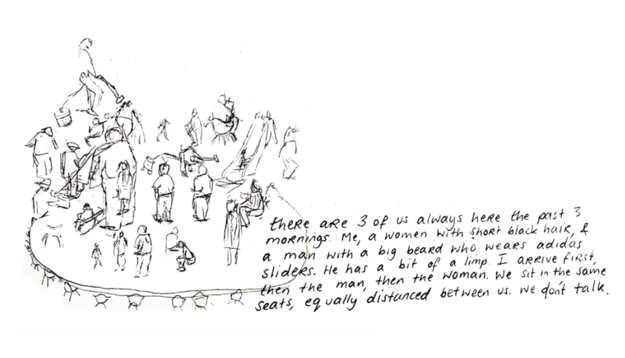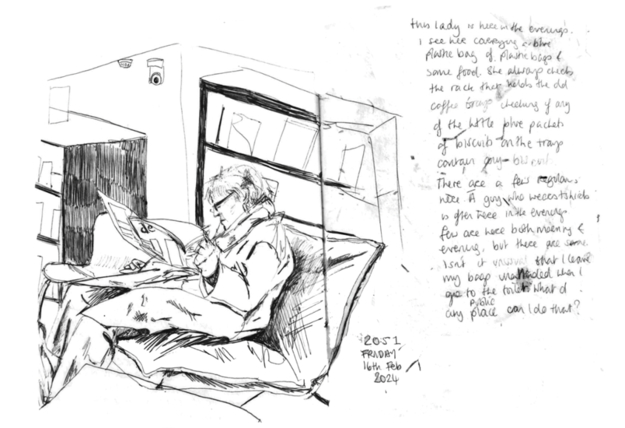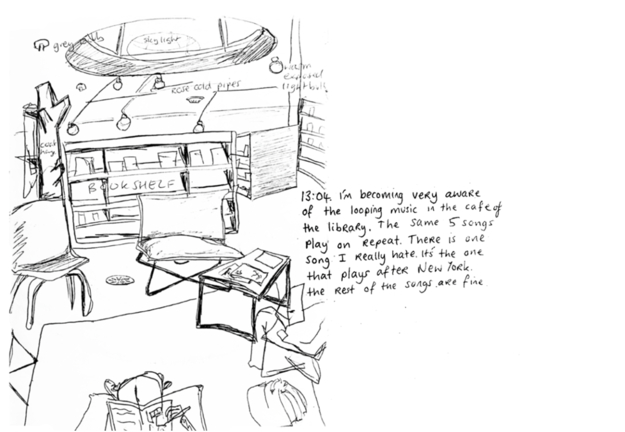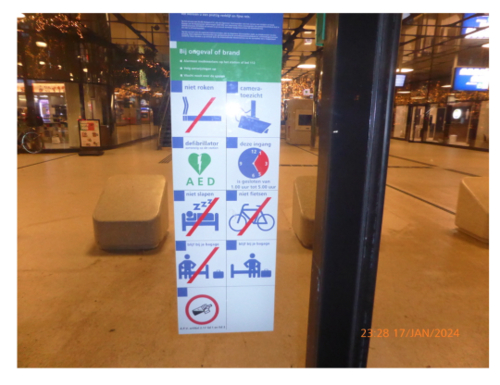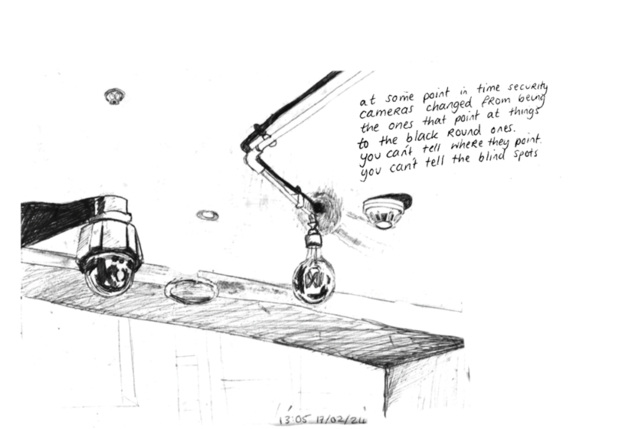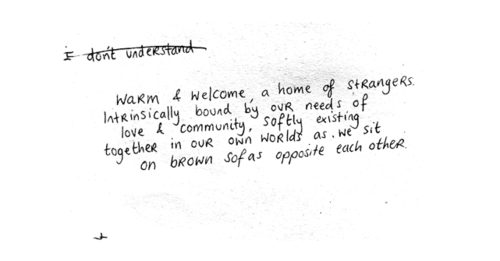Library Life:
The Public Living Room
During my 6 month experiment of living without my own house in the city of Eindhoven, I had to get creative to find alternative ways to meet my needs. Supermarkets became my living rooms, providing shelter on rainy afternoons and internet when I wanted to check my emails. My university became my storage cupboard, and my bike basket became my fridge. I’d rest by sneaking into hotel lobbies and brush my teeth in shop toilets. Cooking was a challenge, so I relied on supermarket food that didn’t need a kitchen. Staying clean also was a difficult. Where do you wash your clothes or shower without a private space?
To sleep I'd often find myself welcomed to friends' places, or stay in people’s rooms if they were leaving for the weekend. Sometimes I stayed with people I didn't know, exchanging work for a place to sleep. I slept in the park only once, this was one of my favourite nights. A few times when I wanted more privacy, I spent the night in school, hiding from the security.
In times of illness and exhaustion, it was the community around me that supported me. This experience of dependence was very beautiful, but it also made me wonder why the city itself is so uninhabitable.
Now no longer based in Eindhoven, I continue to live without a base and explore this subject. Mediamatic invited me to sleep in their building for the month of February. Here I continued to find ways to meet my needs and observed how others met theirs.
25/2/2024 10:06
i am spending my days filling my time and attention with the little area that surrounds the place i sleep. i sleep in amsterdam in an arts centre called mediamatic. there i meet many of my basic needs. food, water and shelter. one remains still: love, community. Here I seek that outside that space.
during the day i build my nest in the public library. located about 2 minutes walk from mediamatic. the library opens at 8am ( except for sat and sun when it opens at 10).
the library has a smell at the beginning of the day. kind of musky. a little thick. The air thins out as the day goes on. Various people wander the floors with vacuum cleaners. bin bags are carried from one place to another, and the library begins to fill with people.
i’ve realised there are few places in the city where I really feel welcome. i experience welcome in the homes of my friends and family or the occasional cosy cafe if i have the money to spend. Public space in the city is full of conditional welcomes: you can sit here if you look right and have this much money to spare. If you don’t tick these boxes, you have to leave.
the library is somewhere I feel very comfortable. I can take off my shoes, leave my bag unattended when I go to the toilet. I can work, I can read. I could spend all my days in the library without ever being expected to spend any money. I am welcome, and so are many others. The library attracts all different kinds of people, bringing all of us together in a shared place. We don’t often talk, but in our nods of recognition, there is a feeling of shared experience. It’s an odd kind of community, but community nonetheless. And in this disconnected world, I’ll take what I can get. I do wish there were more places like this in the city.
I’ve noticed some other regulars who also greet the library at its awakening. I often wonder why other people spend their time here. i sit on whichever sofa takes my fancy, sometimes the one where i have a good view of the library. That’s usually my first spot, where i can watch the events of the day unfold. Later, I move to another sofa, more private but public enough in the hopes the stranger i fancy sits opposite me. He has today. i sit here and i draw and i write. what i see, what i feel.
sometimes i’m frustrated, bored. feel i’m wasting my time. Sometimes I'm peaceful, calm, content with my place and my purpose.
once ive sat in the library for long enough and wrote until i’m repeating the same sentence over and over, i put on my backpack and coat and stroll along the river towards the train station. in my left hand i hold my big heavy water bottle by its handle strap, and in my right, i twiddle a pen between my fingers, passing the pen between each finger with a satisfying twist. as i walk i hum,
as i hum i look at the world.
Like the library, i’ve begun recognising the routine of some others who also orbit the train station. I chat sometimes to La, who stands outside selling magazines. i walk slowly amongst the people, watching them and their loud emotions: greetings of joy, strides of stress, and gazes of confusion beaming up at the train times. Among them I glide, softly absorbing their worlds while they focus on other ones.
i do a loop of the station, passing through the passage under the tracks with the shops. There are seats in the middle of the passage where people sit, eating, talking, or on their phones. some people look in the shops, some people look in the bins.
I proceed to the side of the station by the river. “the back bit” is what I call it in my head. i do a lap round to both ends. there are fewer regulars on this side. Someone sits outside the door on the right. I’ve seen them every day but have not met them yet. I return through the passage under the tracks, and the loop is complete. i exit the station, gently stepping with my hums until i return to the library.
There are similarities between the train station and the library. Both are public places, where lots of different people spend their time. Not everyone in the train station is here to catch a train. The station building provides a level of comfort and can serve as a place to rest. It shelters you from the rain and the wind. There are chairs and benches, sometimes wifi ( if you are near the albert heijn ). The station is open later than the library (I often would go to the station after the libraries closed) . You are not technically allowed to sleep in either, and If the security catch you sleeping, you will be woken up and given a warning.
Tthe library and the train station have a lot of security. The station is full of people in bright yellow clothes, as well as undercover security in civilian clothes. The library has security people sitting at the entrance, watching their computer screens covered in CCTV footage. Both places are lined with security cameras, with people regularly patrolling making sure all their rules are being followed. The train station creates more of a hostile atmosphere, I don’t always feel very
safe there. The library feels calmer, safer and more welcoming. The library security is softened behind the warm lighting, squishy seats and the gentle atmosphere making it much more pleasant to be in. It seems public spaces can only welcome everyone when they are immersed in thorough security protocols. We don’t trust each other.
the pen I mentioned earlier is frequently dropped on the floor as I walk. Sometimes my pen spinning routine does not go to plan and instead of exchanging the pen to the next finger, i give it to the air which swiftly carries it to the floor. I try to pick it up without blocking anyone behind me. The station is always full of rushing people, so I try to do the opposite of them and pick up the pen as slowly as possible. It’s a luxurious position to have time to spare in a busy Amsterdam, so I try make the most of it. This is one of the little games I play on my walks. The pen comes in handy too when I have an idea I want to take note of. I can pause the routine and write the thought on the back of my left hand. These scribbles are useful when I return to the library and decode the cryptic code i put on my skin, reminding me of the thought I wished to remember.
It’s sweet to observe joy in finding ways to fill this time. Spending time without spending money can be a challenge in a city like Amsterdam. In this process of spending time, I notice a sense of home is growing in the daily familiars I encounter in my repetition. A soft time of observation, a gentle way of being together.
I felt more at home in the library than at Mediamatic. Why is that?
The space of Mediamatic is beautiful, and their view of the water is much preferable to the view I got in the library. The building itself is made largely of glass windows. There are no security guards, and only a few CCTV cameras dotted around. The space regulates itself through its culture rather than strict security protocols like the train station and library.
People visiting Mediamatic usually come to see exhibitions or eat at the restaurant. Money is often required to be welcomed in a restaurant, which limits its ability to welcome as broad a range of visitors as the library. This transactional nature makes it less inviting for me.
i feel freer in the library. I’m more anonymous there among the large flow of different characters coming and going. it’s a big space, so it’s easy to not feel observed. I can achieve a feeling of privacy in the library that I never felt at Mediamatic. Maybe that’s because i was the artist in residence, feeling pressure to always look productive.
I’d love to see Mediamatic be more dynamic and open, but the necessity of monetary transactions gets in the way of this. The public library is funded by taxes, and has the resources to welcome people without the need of direct monetary exchange. Mediamatic, despite being a non-profit organisation, relies on a combination of public funds, restaurant income, and ticket sales to sustain itself. This reliance on transactions creates a more exclusive audience, which impacts the welcoming nature of the space. It is important to note that mediamatic hosts many free exhibitions and events that are open to all. By charging for some events, it allows for more unique, specialised experiences that the library can’t offer in its more general accessibility. There is an essential balance to be found between financial sustainability and public accessibility, and i’m happy to see mediamatic are engaging with this challenge.
The public library serves as a living room for all of us. For myself, it’s a place I feel safe, welcome, and able to meet my needs without needing money. Spaces like this are becoming increasingly rare.The library’s ability to provide a sense of community and welcome without imposing financial barriers is a quality I hope inspires all other public spaces and organisations, like Mediamatic.
About the Artist
Sophie Conroy is an artist and embodied researcher. She uses her life as a tool to test different ways of living, creating conditions to explore the unknown and learn more about the world and the self. This includes her research on houseless people and being home/house-less. Ultimately, Sophie explores the question: what do we really need?
Visit her website at: https://sophieconroy.com/




